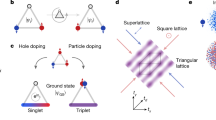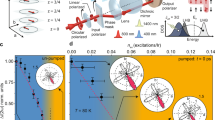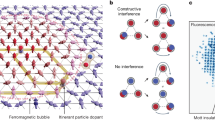Abstract
The interplay of magnetic excitations and itinerant charge carriers is a ubiquitous phenomenon in strongly correlated electron systems. A key theoretical question is understanding the renormalization of the magnon quasiparticle, a collective spin excitation, upon doping a magnetic insulator. Here we observe a new type of quasiparticle—a magnon-Fermi-polaron—arising from the dressing of a magnon with the doped holes of a cold-atom Fermi–Hubbard system. Using Raman excitation with controlled momentum in a doped, spin-polarized band insulator, we address the spectroscopic properties of the magnon-polaron. In an undoped system with strong interactions, photoexcitation produces magnons, whose properties are accurately described by spin-wave theory. We measure the evolution of the photoexcitation spectra as we move away from this limit to produce magnon-polarons due to dressing of the magnons by charge excitations. We observe a shift in the polaron energy with doping that is strongly dependent on the injected momentum, accompanied by a reduction of spectral weight in the probed energy window. We anticipate that the technique introduced here, which is the analogue of inelastic neutron scattering, will provide atomic quantum simulators with access to the dynamics of a wide variety of excitations in strongly correlated phases.
This is a preview of subscription content, access via your institution
Access options
Access Nature and 54 other Nature Portfolio journals
Get Nature+, our best-value online-access subscription
$32.99 / 30 days
cancel any time
Subscribe to this journal
Receive 12 print issues and online access
$259.00 per year
only $21.58 per issue
Buy this article
- Purchase on SpringerLink
- Instant access to full article PDF
Prices may be subject to local taxes which are calculated during checkout




Similar content being viewed by others
Data availability
The experimental data are available from the corresponding author upon reasonable request. Source data are provided with this paper.
Code availability
The relevant codes for this work are available from the corresponding author upon reasonable request.
References
Scalapino, D. J., Loh, E. & Hirsch, J. E. d-wave pairing near a spin-density-wave instability. Phys. Rev. B 34, 8190–8192 (1986).
Scalapino, D. J., Loh, E. & Hirsch, J. E. Fermi-surface instabilities and superconducting d-wave pairing. Phys. Rev. B 35, 6694–6698 (1987).
Anderson, P. W. The resonating valence bond state in La2CuO4 and superconductivity. Science 235, 1196–1198 (1987).
Gros, C., Joynt, R. & Rice, T. M. Antiferromagnetic correlations in almost-localized Fermi liquids. Phys. Rev. B 36, 381–393 (1987).
Zhang, F. C. & Rice, T. M. Effective Hamiltonian for the superconducting Cu oxides. Phys. Rev. B 37, 3759–3761 (1988).
Zhang, F. C., Gros, C., Rice, T. M. & Shiba, H. A renormalised Hamiltonian approach to a resonant valence bond wavefunction. Supercond. Sci. Technol. 1, 36 (1988).
Kotliar, G. & Liu, J. Superexchange mechanism and d-wave superconductivity. Phys. Rev. B 38, 5142–5145 (1988).
Schrieffer, J. R., Wen, X.-G. & Zhang, S.-C. Spin-bag mechanism of high-temperature superconductivity. Phys. Rev. Lett. 60, 944–947 (1988).
Monthoux, P., Balatsky, A. V. & Pines, D. Toward a theory of high-temperature superconductivity in the antiferromagnetically correlated cuprate oxides. Phys. Rev. Lett. 67, 3448–3451 (1991).
Monthoux, P., Balatsky, A. V. & Pines, D. Weak-coupling theory of high-temperature superconductivity in the antiferromagnetically correlated copper oxides. Phys. Rev. B 46, 14803–14817 (1992).
Dai, P., Mook, H. A., Hunt, R. D. & Doğan, F. Evolution of the resonance and incommensurate spin fluctuations in superconducting YBa2Cu3O6+x. Phys. Rev. B 63, 054525 (2001).
Anderson, P. W. et al. The physics behind high-temperature superconducting cuprates: the ‘plain vanilla’ version of RVB. J. Phys. Condens. Matter 16, R755 (2004).
Anderson, P. W. Physics of the resonating valence bond (pseudogap) state of the doped Mott insulator: spin-charge locking. Phys. Rev. Lett. 96, 017001 (2006).
Edegger, B., Muthukumar, V. N. & Gros, C. Gutzwiller-RVB theory of high-temperature superconductivity: results from renormalized mean-field theory and variational Monte Carlo calculations. Adv. Phys. 56, 927–1033 (2007).
Dahm, T. et al. Strength of the spin-fluctuation-mediated pairing interaction in a high-temperature superconductor. Nat. Phys. 5, 217–221 (2009).
Le Tacon, M. et al. Intense paramagnon excitations in a large family of high-temperature superconductors. Nat. Phys. 7, 725–730 (2011).
Dean, M. P. M. et al. Persistence of magnetic excitations in La2−xSrxCuO4 from the undoped insulator to the heavily overdoped non-superconducting metal. Nat. Mater. 12, 1019–1023 (2013).
Lu, H. et al. Magnetic excitations in infinite-layer nickelates. Science 373, 213–216 (2021).
Fowlie, J. et al. Intrinsic magnetism in superconducting infinite-layer nickelates. Nat. Phys. 18, 1043–1047 (2022).
Miyake, K., Schmitt-Rink, S. & Varma, C. M. Spin-fluctuation-mediated even-parity pairing in heavy-fermion superconductors. Phys. Rev. B 34, 6554–6556 (1986).
Mathur, N. D. et al. Magnetically mediated superconductivity in heavy fermion compounds. Nature 394, 39–43 (1998).
White, B., Thompson, J. & Maple, M. Unconventional superconductivity in heavy-fermion compounds. Physica C 514, 246–278 (2015).
Zhou, H. et al. Isospin magnetism and spin-polarized superconductivity in Bernal bilayer graphene. Science 375, 774–778 (2022).
de la Barrera, S. C. et al. Cascade of isospin phase transitions in Bernal-stacked bilayer graphene at zero magnetic field. Nat. Phys. 18, 771–775 (2022).
Cao, Y. et al. Unconventional superconductivity in magic-angle graphene superlattices. Nature 556, 43–50 (2018).
Sharpe, A. L. et al. Emergent ferromagnetism near three-quarters filling in twisted bilayer graphene. Science 365, 605–608 (2019).
Chen, G. et al. Tunable correlated Chern insulator and ferromagnetism in a moiré superlattice. Nature 579, 56–61 (2020).
Tang, Y. et al. Simulation of Hubbard model physics in WSe2/WS2 moiré superlattices. Nature 579, 353–358 (2020).
Ciorciaro, L. et al. Kinetic magnetism in triangular moiré materials. Nature 623, 509–513 (2023).
Tang, Y. et al. Evidence of frustrated magnetic interactions in a Wigner–Mott insulator. Nat. Nanotechnol. 18, 233–237 (2023).
Xia, Y. et al. Superconductivity in twisted bilayer WSe2. Nature 637, 833–838 (2025).
Scalapino, D. J. A common thread: the pairing interaction for unconventional superconductors. Rev. Mod. Phys. 84, 1383–1417 (2012).
Keimer, B., Kivelson, S. A., Norman, M. R., Uchida, S. & Zaanen, J. From quantum matter to high-temperature superconductivity in copper oxides. Nature 518, 179–186 (2015).
Migdal, A. B. Interaction between electrons and lattice vibrations in a normal metal. Sov. Phys. JETP 34, 996–1001 (1958).
Eliashberg, G. M. Interactions between electrons and lattice vibrations in a superconductor. Sov. Phys. JETP 11, 696–702 (1960).
Bourges, P. et al. The spin excitation spectrum in superconducting YBa2Cu3O6.85. Science 288, 1234–1237 (2000).
Tranquada, J. M. et al. Quantum magnetic excitations from stripes in copper oxide superconductors. Nature 429, 534–538 (2004).
Hayden, S. M., Mook, H. A., Dai, P., Perring, T. G. & Doğan, F. The structure of the high-energy spin excitations in a high-transition-temperature superconductor. Nature 429, 531–534 (2004).
Wakimoto, S. et al. Disappearance of antiferromagnetic spin excitations in overdoped La2−xSrxCuO4. Phys. Rev. Lett. 98, 247003 (2007).
Braicovich, L. et al. Dispersion of magnetic excitations in the cuprate La2CuO4 and CaCuO2 compounds measured using resonant x-ray scattering. Phys. Rev. Lett. 102, 167401 (2009).
Braicovich, L. et al. Magnetic excitations and phase separation in the underdoped La2−xSrxCuO4 superconductor measured by resonant inelastic x-ray scattering. Phys. Rev. Lett. 104, 077002 (2010).
Ament, L. J. P., van Veenendaal, M., Devereaux, T. P., Hill, J. P. & van den Brink, J. Resonant inelastic x-ray scattering studies of elementary excitations. Rev. Mod. Phys. 83, 705–767 (2011).
Chaix, L. et al. Resonant inelastic x-ray scattering studies of magnons and bimagnons in the lightly doped cuprate La2−xSrxCuO4. Phys. Rev. B 97, 155144 (2018).
Devereaux, T. P. & Hackl, R. Inelastic light scattering from correlated electrons. Rev. Mod. Phys. 79, 175–233 (2007).
Fujita, M. et al. Progress in neutron scattering studies of spin excitations in high-Tc cuprates. J. Phys. Soc. Jpn 81, 011007 (2012).
Ji, G. et al. Coupling a mobile hole to an antiferromagnetic spin background: transient dynamics of a magnetic polaron. Phys. Rev. X 11, 021022 (2021).
Koepsell, J. et al. Imaging magnetic polarons in the doped Fermi–Hubbard model. Nature 572, 358–362 (2019).
Prichard, M. L. et al. Directly imaging spin polarons in a kinetically frustrated Hubbard system. Nature 629, 323–328 (2024).
Lebrat, M. et al. Observation of Nagaoka polarons in a Fermi–Hubbard quantum simulator. Nature 629, 317–322 (2024).
Hartke, T., Oreg, B., Turnbaugh, C., Jia, N. & Zwierlein, M. Direct observation of nonlocal fermion pairing in an attractive Fermi–Hubbard gas. Science 381, 82–86 (2023).
Schirotzek, A., Wu, C.-H., Sommer, A. & Zwierlein, M. W. Observation of Fermi polarons in a tunable Fermi liquid of ultracold atoms. Phys. Rev. Lett. 102, 230402 (2009).
Koschorreck, M. et al. Attractive and repulsive Fermi polarons in two dimensions. Nature 485, 619–622 (2012).
Kohstall, C. et al. Metastability and coherence of repulsive polarons in a strongly interacting Fermi mixture. Nature 485, 615–618 (2012).
Cetina, M. et al. Ultrafast many-body interferometry of impurities coupled to a Fermi sea. Science 354, 96–99 (2016).
Yan, Z. Z., Ni, Y., Robens, C. & Zwierlein, M. W. Bose polarons near quantum criticality. Science 368, 190–194 (2020).
Ness, G. et al. Observation of a smooth polaron–molecule transition in a degenerate Fermi gas. Phys. Rev. X 10, 041019 (2020).
Parish, M. M. & Levinsen, J. Highly polarized Fermi gases in two dimensions. Phys. Rev. A 87, 033616 (2013).
Jørgensen, N. B. et al. Observation of attractive and repulsive polarons in a Bose–Einstein condensate. Phys. Rev. Lett. 117, 055302 (2016).
Hu, M.-G. et al. Bose polarons in the strongly interacting regime. Phys. Rev. Lett. 117, 055301 (2016).
Darkwah Oppong, N. et al. Observation of coherent multiorbital polarons in a two-dimensional Fermi gas. Phys. Rev. Lett. 122, 193604 (2019).
Duda, M. et al. Transition from a polaronic condensate to a degenerate Fermi gas of heteronuclear molecules. Nat. Phys. 19, 720–725 (2023).
Zürn, G. et al. Precise characterization of 6Li Feshbach resonances using trap-sideband-resolved RF spectroscopy of weakly bound molecules. Phys. Rev. Lett. 110, 135301 (2013).
Navarro, I. M., Weitenberg, C., Sengstock, K. & Demler, E. Exploring kinetically induced bound states in triangular lattices with ultracold atoms: spectroscopic approach. SciPost Phys. 16, 081 (2024).
Vaknin, D. et al. Antiferromagnetism in La2CuO4−y. Phys. Rev. Lett. 58, 2802 (1987).
Fong, H. F. et al. Spin susceptibility in underdoped YBa2Cu3O6+x. Phys. Rev. B 61, 14773–14786 (2000).
Fong, H. et al. Neutron scattering from magnetic excitations in Bi2Sr2CaCu2O8+δ. Nature 398, 588–591 (1999).
Chevy, F. Universal phase diagram of a strongly interacting Fermi gas with unbalanced spin populations. Phys. Rev. A 74, 063628 (2006).
Mora, C. & Chevy, F. Ground state of a tightly bound composite dimer immersed in a Fermi sea. Phys. Rev. A 80, 033607 (2009).
Punk, M., Dumitrescu, P. T. & Zwerger, W. Polaron-to-molecule transition in a strongly imbalanced Fermi gas. Phys. Rev. A 80, 053605 (2009).
Lovesey, S. W. Theory of Neutron Scattering from Condensed Matter (Oxford Univ. Press, 1984).
Brown, P. T. et al. Spin-imbalance in a 2D Fermi–Hubbard system. Science 357, 1385–1388 (2017).
Acknowledgements
We thank L. Cheuk for helpful discussions, and A. Hasan for assistance in early stages of this work. The experimental work was supported by the NSF (grant no. 2110475 and QLCI grant no. OMA-2120757), the David and Lucile Packard Foundation (grant no. 2016-65128) and the ONR (grant no. N00014-21-1-2646). M.L.P. was supported by the NSF Graduate Research Fellowship Program. D.A.H. was supported in part by NSF QLCI grant no. OMA-2120757. I.M. and E.D. were supported by the SNSF (project 200021_212899), the Swiss State Secretariat for Education, Research and Innovation (contract number UeM019-1) and the ARO (grant no. W911NF-20-1-0163).
Author information
Authors and Affiliations
Contributions
M.L.P., Z.B. and B.M.S. performed the experiments and analysed the data. W.S.B. conceived the study and supervised the experiment. I.M., E.D. and D.A.H. developed the theory. I.M. performed the numerical calculations. All authors contributed to writing the paper.
Corresponding author
Ethics declarations
Competing interests
The authors declare no competing interests.
Peer review
Peer review information
Nature Physics thanks Ariel Sommer and the other, anonymous, reviewer(s) for their contribution to the peer review of this work.
Additional information
Publisher’s note Springer Nature remains neutral with regard to jurisdictional claims in published maps and institutional affiliations.
Supplementary information
Supplementary Information
Supplementary text, Figs. 1–5 and refs. 1–12.
Source data
Source Data Fig. 1
Data for experimental axes (1d,e).
Source Data Fig. 2
Data for experimental axes (2a–c).
Source Data Fig. 3
Data for experimental axes (3a,b,d,e).
Source Data Fig. 4
Data for experimental axes (4c and inset).
Rights and permissions
Springer Nature or its licensor (e.g. a society or other partner) holds exclusive rights to this article under a publishing agreement with the author(s) or other rightsholder(s); author self-archiving of the accepted manuscript version of this article is solely governed by the terms of such publishing agreement and applicable law.
About this article
Cite this article
Prichard, M.L., Ba, Z., Morera, I. et al. Magnon-polarons in the Fermi–Hubbard model. Nat. Phys. (2025). https://doi.org/10.1038/s41567-025-03004-6
Received:
Accepted:
Published:
DOI: https://doi.org/10.1038/s41567-025-03004-6



